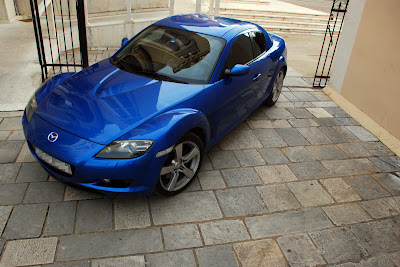So far, I have sung the praise of the RX-8 and its multi-layered character. Yet, in 21 years of driving, it was in my current steed that I came closer than ever to having the one thing every driver fears the most: THE BIG ONE.
It was late at night and raining. Getting wheel spin in first, second and third earlier, I had switched the traction control back on as the slimy surface didn�t warrant any heroics.
Less than half a mile from home, there�s a tricky left-hander that is extremely slippery in the entry even when it�s dry. I�ve crossed it a zillion times in many different cars and at various speeds.
Entering that bend at maybe 30-40 mph (50-65 km/h) the instant I turned the wheel the RX-8 didn�t oversteer or understeer at all. Instead, it scythed its own trajectory, crossed over to the opposite lane and headed for the sole stretch of barrier in maybe 10 miles or so.
I can�t quite recall if the DSC intervened at all, only my hands sawing at the wheel and my right foot firmly pressing the brake pedal as I was watching the barrier approaching through the driver�s side window!
As I was bracing myself for the force of impact, the sound of metal crunched and the airbags going off, it came to a halt. I could see the barrier inches away from my face, so close I didn�t even dare open the door. The car had stopped at a slight angle to the barriers so I checked the left mirror to see if the rear wing had made contact. It hadn�t.
I had scrubbed enough speed off so if I had crashed, it would probably damage the car and, subsequently, my pockets and ego.... Even so, if someone was coming from the opposite direction the consequences would be much direr and it would all be my fault.
Had I seriously misjudged the conditions? Had I become complacent due to the forgiving handling and the safety net of electronics? Damn, if I was going too fast it should have warned me like it had until then, no matter the road conditions, and it didn�t.
The next morning I was walking towards the car when I noticed something was askew. The left front tire was completely flat! When it was removed, I discovered a screw in the inner side of the tread. I must have picked it up prior to the near miss as it had tracked and steered faultlessly up to that point.
Partly relieved that it wasn�t my or the car�s fault, I was still dumbfounded by the realization that there was nothing I could have done to prevent the car from veering off the road. It was a freak occurrence and I was fortunate to walk away with not a scratch and without hurting anyone else.
On another note, the odometer may have read only had 68,000 km (42,000 miles) on it, but the calendar showed that its six-year/120,000 km (75,000-mile) service beckoned. It was a big one too, because apart from the usual engine oil/filter job and various checks, it should have its gearbox oil and spark plugs changed.
Rotary-powered Mazdas are not the DIY kind of cars and I searched for someone with experience on servicing them � preferably lots of it. The specialist I took it too came highly recommended and the presence of other RX-8s, including one he had prepared for racing as well as him not objecting to me being present, were a good sign.
In spite of charging a mere �50 (about US$66 at the current exchange rates) for labor, the parts came in at nearly �450 (US$595). That burned a nice, round �500 (US$660) hole in my pocket. If in any car proper maintenance can save you from a much more expensive problem down the road, in rotary engine-powered models it is even more imperative, unless you already have a spare engine sitting in your garage�
Articles Source : Carscoop






No comments:
Post a Comment